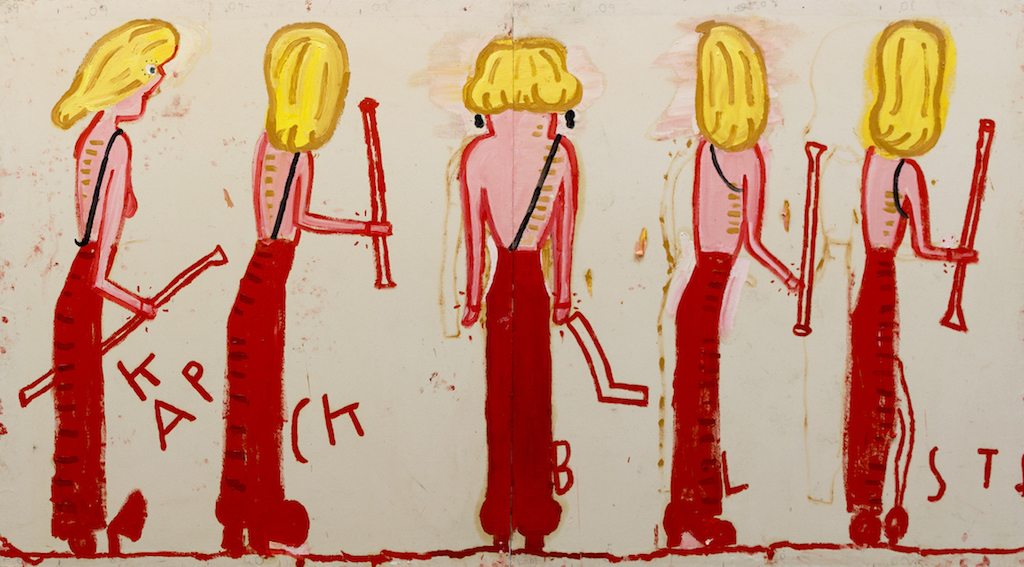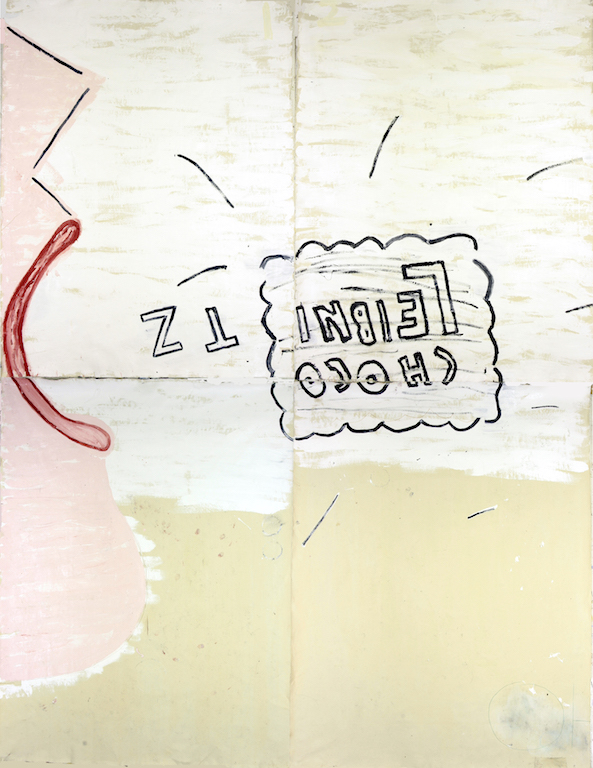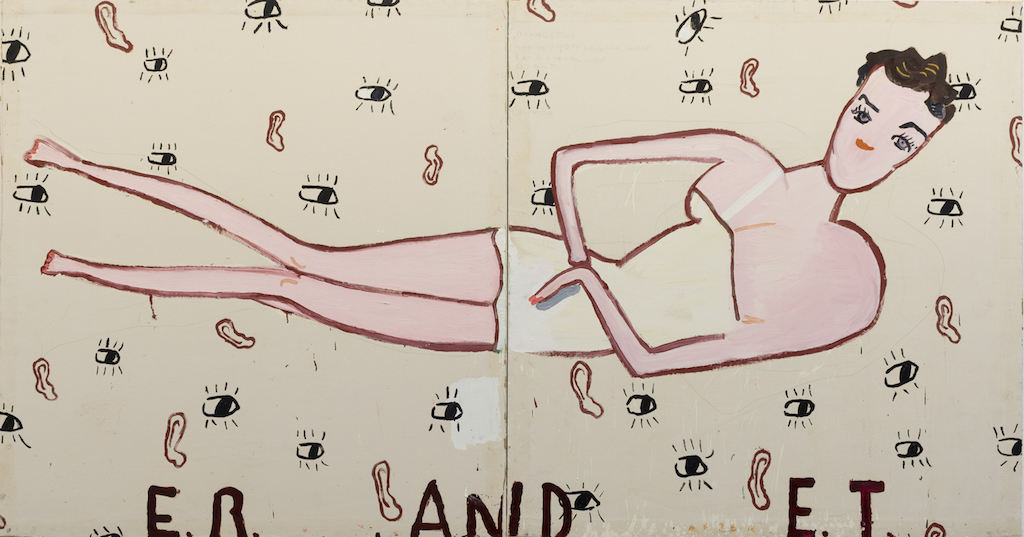Rose Wylie: Quack Quack, Serpentine Gallery - anarchy at 83 | reviews, news & interviews
Rose Wylie: Quack Quack, Serpentine Gallery - anarchy at 83
Rose Wylie: Quack Quack, Serpentine Gallery - anarchy at 83
The octogenarian who paints with the fresh eye of a child

Three years ago Rose Wylie won the prestigious John Moore’s Painting Prize. She was 80 years old and had been painting away in relative obscurity for many decades. You might suppose, then, that the prize was given in recognition of past achievements – a reward for dogged perseverance.
She painted figuratively when abstraction was all the rage, yet refused to conform to expectations of what figurative painting might be about. Her outline drawings are more like pictograms – records of how things are lodged in the mind – than representations of how they appear to the eye. Rather than registering outward appearances, she seems to be mapping her internal reservoir of images, thoughts and memories.
Her paintings look naive, and because the canvases are large and the imagery is apparently simple, one tends to stand back to take then in; yet they make real sense only if you go in close and stand in the artist’s shoes, as it were. Once inside her forcefield, you begin to sense the logic of how each picture is constructed. Take, for instance, Rosemount (Coloured), 1999, a painting from the Early Memory series. At the centre is the black silhouette of a house the artist lived in as a child during World War II. Exploding doodlebugs plummet down from the sky while another bomb cruises overhead in red outline. Everything else is sketchy; blades of grass are dotted around to suggest a lawn, the privet hedge is only a smudge of green and the chicken-run a criss-cross of grey lines. Allotments, flowerbeds, fruit trees and vegetables are suggested by patches of colour and labels.
Take, for instance, Rosemount (Coloured), 1999, a painting from the Early Memory series. At the centre is the black silhouette of a house the artist lived in as a child during World War II. Exploding doodlebugs plummet down from the sky while another bomb cruises overhead in red outline. Everything else is sketchy; blades of grass are dotted around to suggest a lawn, the privet hedge is only a smudge of green and the chicken-run a criss-cross of grey lines. Allotments, flowerbeds, fruit trees and vegetables are suggested by patches of colour and labels.
In the foreground is the outline of a face with closed eyes; an arrow points into the picture from one eye, as though to indicate where the memories are flowing from. An exercise in recollection, the painting is more about the act of remembering than the place where Wylie lived as a child. Since this involves thinking back across many decades, the years she is recalling are inscribed on the picture as 1944-40 – a reversal of the normal order that in this context makes perfect sense.
Memory is a rich resource, but paintings, films and photographs are also grist to the mill. Something in the media will catch Wylie’s eye and find its way into a painting, not so much because of its social or political import as for its shape and colour, or an apparently random detail. The backless dress worn by Nicole Kidman for a red-carpet event in Cannes attracted her attention, for instance, because it was held up by a single black strap. In NK (Syracuse Line-UP) 2014 (pictured above) the actress appears multiple times, as on a film strip or in an Egyptian frieze. And as if to suggest that celebrities are the contemporary equivalents of saints, Wylie has equipped her with a dagger, an attribute of St Lucy, who was put to the sword for her faith in 304 AD and to this day is commemorated as patron saint of Syracuse.
 For me, Wylie’s paintings are like a stream-of-consciousness snapshot of the way the mind works. Associations are triggered and connections sparked across time and space by a name, a visual cue, or some trivial detail. In one painting Queen Elizabeth I is linked with a film star, and in another with a flower.
For me, Wylie’s paintings are like a stream-of-consciousness snapshot of the way the mind works. Associations are triggered and connections sparked across time and space by a name, a visual cue, or some trivial detail. In one painting Queen Elizabeth I is linked with a film star, and in another with a flower.
In Queen with Pansies (Dots), 2016 (main picture) Wylie paints a simplified version of the monarch as portrayed by Marcus Gheeraerts the Younger in the iconic Ditchley Portrait of 1592. In the original, Elizabeth I is dressed in a bejewelled white gown whose voluminous skirt and upholstered shoulders make her look like a piece of furniture. Exaggerating this extraordinary shape even further, Wylie turns the queen into a sofa or throne, yet still conveys a sense of the human being trapped within this majestic panoply. Incongruously, Elizabeth is surrounded by pansies that echo the shape of the lace tiers attached to her shoulders like wings. Pencilled onto the picture are comments such as “window box pansies” and the measurements of the canvas, as though Wylie were talking to herself rather than an audience.
In the Rainbow Portrait of 1600, also attributed to Gheeraerts, Elizabeth’s cloak is decorated with eyes and ears, as though to suggest that nothing escapes her knowledge. In Wylie’s painting ER and ET, 2011 (pictured below), eyes and ears surround the reclining figure of Liz Taylor; rather than indicating the power of this modern day Elizabeth, they evoke the ubiquitous presence of the press and her adoring fans, and the endless scrutiny to which she was subjected. Painted the year Taylor died, the picture celebrates her career with a list of films in which she starred. You have to search for it, though, since it is written faintly in pencil – a comment, perhaps, on the way women are more often admired for their looks than their achievements. My favourite painting (pictured above right) looks almost abstract. Made up of four canvases joined into a single composition, it features a rectangle with a curly black edge labelled "CHOCO LEIBNI... TZ" in upside-down capitals. Large sections of the canvas are bare or thinly scumbled with white. On the left is a red arc resembling a frankfurter, which turns out to be an open mouth about to munch the Leibnitz biscuit. Situated in between lyrical abstraction and pop art, it reveals the level of sophistication hidden behind the apparent simplicity of Wylie’s paintings.
My favourite painting (pictured above right) looks almost abstract. Made up of four canvases joined into a single composition, it features a rectangle with a curly black edge labelled "CHOCO LEIBNI... TZ" in upside-down capitals. Large sections of the canvas are bare or thinly scumbled with white. On the left is a red arc resembling a frankfurter, which turns out to be an open mouth about to munch the Leibnitz biscuit. Situated in between lyrical abstraction and pop art, it reveals the level of sophistication hidden behind the apparent simplicity of Wylie’s paintings.
Her work feels like a restless enquiry into what painting might contribute to the electronic age, and it is this sense of endless searching plus the irreverent humour that keeps her pictures so fresh and alive.
- Rose Wylie: Quack Quack at the Serpentine Gallery to 11 February 2018
- More visual arts reviews on theartsdesk
rating
Explore topics
Share this article
The future of Arts Journalism
You can stop theartsdesk.com closing!
We urgently need financing to survive. Our fundraising drive has thus far raised £49,000 but we need to reach £100,000 or we will be forced to close. Please contribute here: https://gofund.me/c3f6033d
And if you can forward this information to anyone who might assist, we’d be grateful.

Subscribe to theartsdesk.com
Thank you for continuing to read our work on theartsdesk.com. For unlimited access to every article in its entirety, including our archive of more than 15,000 pieces, we're asking for £5 per month or £40 per year. We feel it's a very good deal, and hope you do too.
To take a subscription now simply click here.
And if you're looking for that extra gift for a friend or family member, why not treat them to a theartsdesk.com gift subscription?
more Visual arts
 'We are bowled over!' Thank you for your messages of love and support
Much-appreciated words of commendation from readers and the cultural community
'We are bowled over!' Thank you for your messages of love and support
Much-appreciated words of commendation from readers and the cultural community
![SEX MONEY RACE RELIGION [2016] by Gilbert and George. Installation shot of Gilbert & George 21ST CENTURY PICTURES Hayward Gallery](https://theartsdesk.com/sites/default/files/styles/thumbnail/public/mastimages/Gilbert%20%26%20George_%2021ST%20CENTURY%20PICTURES.%20SEX%20MONEY%20RACE%20RELIGION%20%5B2016%5D.%20Photo_%20Mark%20Blower.%20Courtesy%20of%20the%20Gilbert%20%26%20George%20and%20the%20Hayward%20Gallery._0.jpg?itok=7tVsLyR-) Gilbert & George, 21st Century Pictures, Hayward Gallery review - brash, bright and not so beautiful
The couple's coloured photomontages shout louder than ever, causing sensory overload
Gilbert & George, 21st Century Pictures, Hayward Gallery review - brash, bright and not so beautiful
The couple's coloured photomontages shout louder than ever, causing sensory overload
 Lee Miller, Tate Britain review - an extraordinary career that remains an enigma
Fashion photographer, artist or war reporter; will the real Lee Miller please step forward?
Lee Miller, Tate Britain review - an extraordinary career that remains an enigma
Fashion photographer, artist or war reporter; will the real Lee Miller please step forward?
 Kerry James Marshall: The Histories, Royal Academy review - a triumphant celebration of blackness
Room after room of glorious paintings
Kerry James Marshall: The Histories, Royal Academy review - a triumphant celebration of blackness
Room after room of glorious paintings
 Folkestone Triennial 2025 - landscape, seascape, art lovers' escape
Locally rooted festival brings home many but not all global concerns
Folkestone Triennial 2025 - landscape, seascape, art lovers' escape
Locally rooted festival brings home many but not all global concerns
 Sir Brian Clarke (1953-2025) - a personal tribute
Remembering an artist with a gift for the transcendent
Sir Brian Clarke (1953-2025) - a personal tribute
Remembering an artist with a gift for the transcendent
 Emily Kam Kngwarray, Tate Modern review - glimpses of another world
Pictures that are an affirmation of belonging
Emily Kam Kngwarray, Tate Modern review - glimpses of another world
Pictures that are an affirmation of belonging
 Kiefer / Van Gogh, Royal Academy review - a pairing of opposites
Small scale intensity meets large scale melodrama
Kiefer / Van Gogh, Royal Academy review - a pairing of opposites
Small scale intensity meets large scale melodrama
 Jenny Saville: The Anatomy of Painting, National Portrait Gallery review - a protégé losing her way
A brilliant painter in search of a worthwhile subject
Jenny Saville: The Anatomy of Painting, National Portrait Gallery review - a protégé losing her way
A brilliant painter in search of a worthwhile subject
 Abstract Erotic, Courtauld Gallery review - sculpture that is sensuous, funny and subversive
Testing the boundaries of good taste, and winning
Abstract Erotic, Courtauld Gallery review - sculpture that is sensuous, funny and subversive
Testing the boundaries of good taste, and winning
 Edward Burra, Tate Britain review - watercolour made mainstream
Social satire with a nasty bite
Edward Burra, Tate Britain review - watercolour made mainstream
Social satire with a nasty bite
 Ithell Colquhoun, Tate Britain review - revelations of a weird and wonderful world
Emanations from the unconscious
Ithell Colquhoun, Tate Britain review - revelations of a weird and wonderful world
Emanations from the unconscious

Add comment